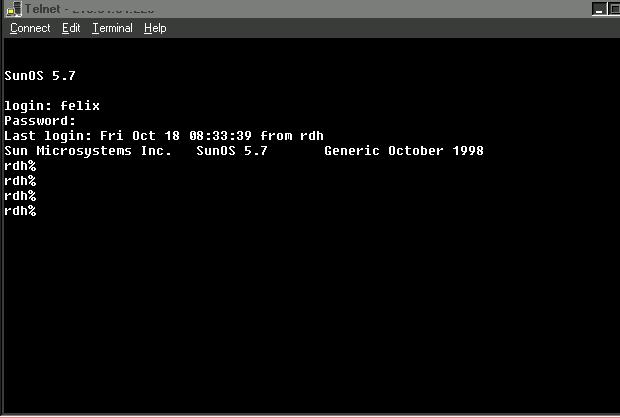
Lots of people have told you that Linux is cheaper than Microsoft's Windows brand systems; this column explores a different question: what are the risks and consequences of using it at home?
In today's installment I'll look at what Linux looks like on screen and what you have to know to use it.
As you know Linux is a Unix variant and you know how Unix compares visually to Windows, right?
Unix:

Windows XP:

Making this choice would, of course, be an absolute no brainer if these images accurately reflected the appearance of the two operating systems; but they don't.
Unix only looks like a barely readable collection of tiny yellow squiggles on a black background when you look at it through a Microsoft Window; remove that PC filter and the picture changes.
In reality, there are four major, and several minor, advanced graphical user interfaces to Unix; all different, and yet all the same in ways that go well beyond the surface similarity of many Windows products.
sets the world standard for graphical user interfaces.
Not terribly attractive, but extremely functional. Users can, of course, jazz up CDE's appearance considerably, but to me it's a heavy duty truck and I don't bother with pretty.
If you click on the image (use your "back" button to return) to see this in its natural size, you'll notice that I'm using vi to edit this document while displaying it using Netscape 4.76 as a check on my HTML.
To many people vi is another of those monsters Unix hides under the bed, something often cited as evidence of the thing's hopeless geekiness. It's true too, more than a few users have been driven away from Unix by trying to use it in a Microsoft telnet window --in part because it is hard to learn and in part because Microsoft's Windows telnet doesn't correctly handle the control characters vi requires.
However, as a home Linux user you do not need to learn vi. I use it because I've invested in learning how to use it and, for me, that makes it fast and efficient. You could choose to do that too; but I'd only recommend it if you wanted to become technically proficient with Linux or any other Unix as a programmer or administrator. If you just want to use Linux effectively, well, you don't have to get a pilot's license to use a jet do you?
Here's a screen shot from the KDE website:
So what do you have to know to use one of these? Nothing specific to Unix; basically, if you can point a mouse, read a label, and click, you can start up a spreadsheet, word processor, or any one of thousands of other applications. Then you have to know how to use the tool; but that has nothing to do with Linux.
Making a choice is neither hard nor necessary. Most linux distributions come with at least KDE and GNOME, allowing you to choose one when you login and it is even possible - although not widely recommended- to run two or three GUIs at once.
So what does Linux look like? I think the word is "beautiful," and not just because it looks good; it has deeper virtues than that: including complete personal productivity suites, high reliability, pretty good security, and a trust the user attitude that doesn't send you out to buy a self denigrating "dummies" book just so you can figure out that you use the start button to stop the machine.
So, bottom line, is Linux "geeky"? nope, it's way cool.
next in series (using Office tools)